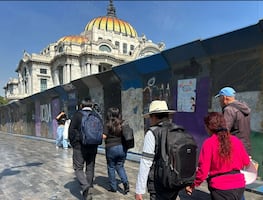Más Información

Gutiérrez Luna acusa que Cabeza de Vaca es cuidado por 36 policías con cargo al erario; reporta gasto de casi 2 mdp al mes

Azucena Uresti denuncia acoso y espionaje de Noroña tras filtración de datos privados; “es un acumulador de mentiras”, señala

CNTE arranca movilizaciones para este 13 de noviembre en la CDMX; se deslinda de marcha de la Generación Z

Gobierno de Nuevo León aclara que Nvidia no invertirá en la entidad, sino la compañía Cipre Holdings

Hackean páginas de "Madres Buscadoras de Sonora" en varios estados; Ceci Flores denuncia nuevas amenazas y represión

Reanudan "Operación Sable" en Juchitán, Oaxaca, tras aumento de violencia y asesinato de la niña Noelia Daylen
President Andrés Manuel López Obrador inaugurated a dam in northern Mexico on Wednesday even though work was symbolically suspended by anthropologists because it is flooding thousand-year-old Indigenous sites containing rock carvings and the remains of pre-Hispanic dwellings.
The Los Pilares dam is the latest in a series of government infrastructure projects that López Obrador has promoted but that have caused divisions and anger in Indigenous communities.
The area around the Mayo river in Sonora state is home to the Guarijío people, who also call themselves Macorahui. The Guarijío, of whom only a little over 2,000 remain, are divided over the dam.
In a strange turn of events late Tuesday, authorities of the National Institute of Anthropology and History (INAH) put suspension stickers on the Los Pilares dam , a move used to close building projects that threaten archaeological remains. However, the 73-yard high flood-control dam, which has cost about $75 million since construction started in 2013, is already built and water levels are rising behind it.
Recommended:
“As a serious institution, we had to send a warning that there is cultural legacy there that must be saved,” said anthropologist José Luis Perea, director of the institute’s office in Sonora.
Of the 44 sites identified in the area, 34 hold remains of homes or temporary camps. Eleven sites hold about 140 ancient rock carvings, which depict human, animal, and abstract forms.
During an inspection of the sites at the beginning of August, “we realized that the dam has already flooded 10 sites with petroglyphs” and as many as 20 sites in total may soon be underwater,” Perea said.
The suspension stickers were largely symbolic because archaeologists reached an agreement with local and federal water agencies to wait until Mexico’s rainy season ends in October to allow water levels behind the dam to fall and rescue what they can from the ancient sites.
Archaeologists will study and remove 1,100-year-old ceramics and stone tools from the river valley and make three-dimensional models of the petroglyphs before water levels rise again. The models will be used to make reproductions. Removing the carvings appears out of the question.
Because water levels will vary by season, some sites will always be underwater in the future, but some for only part of the year. Experts hope to apply some protective treatment to the rock carvings to help them survive better.
The Guarijío, many of whom raise cattle, were promised benefits in return for allowing the dam, but it is unclear how much has reached them.
“Part of the (Guarijíoi) authorities and people are in agreement with it, and part of the authorities and people don’t agree with it,” Perea said.
Juan Rodriguez, a Guarijío representative who spoke at the inauguration of the dam , said, “I think it will benefit the tribe.” But he pointedly asked for help “with all the promises that have been left hanging,” mentioning housing, schools, and healthcare.
Recommended:
López Obrador said too much government money had already been invested in the dam by the time he took office in 2018 to halt the project. The president, who fiercely argues against wasting government money, has used a similar argument to continue with projects in other parts of the country.
“Don’t worry, we are going to fulfill all the promises ... so that you don’t remain on the margins of development,” López Obrador told the Guarijío representatives.
It is not the first time that López Obrador’s love of government infrastructure projects has put him at odds with Indigenous communities.
In July, he inaugurated the start of construction on the Mayan train, which would run some 1,500 kilometers in a rough loop around the Yucatán peninsula. The train will run from Caribbean beaches to the peninsula’s interior while stimulating economic development around its 15 stations. The government says it will cost as much as $6.8 billion, but others say it will be much more.
Some Mayan communities have filed court challenges against the train project, arguing that it will cause environmental damage . They also say they were not adequately consulted about it or they will not share in its benefits.
mp
Noticias según tus intereses
[Publicidad]
[Publicidad]








